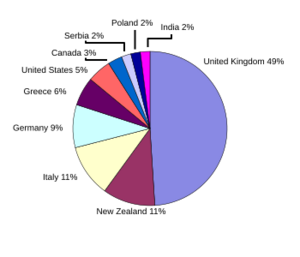Dulwich, South Australia facts for kids
Quick facts for kids DulwichAdelaide, South Australia |
|||||||||||||||
|---|---|---|---|---|---|---|---|---|---|---|---|---|---|---|---|
| Established | 1854 | ||||||||||||||
| Postcode(s) | 5065 | ||||||||||||||
| LGA(s) | City of Burnside | ||||||||||||||
| State electorate(s) | Dunstan | ||||||||||||||
| Federal Division(s) | Sturt | ||||||||||||||
|
|||||||||||||||
Dulwich is a suburb in Adelaide, South Australia. It is part of the City of Burnside area. About 2,663 people live here. Dulwich is next to Adelaide's east parklands. It is on the western edge of the City of Burnside.
Dulwich has both homes and businesses. Many offices and shops are found along Fullarton and Greenhill Roads. The suburb is next to Rose Park to the north. To the east is Toorak Gardens. Glenside is to the south. The Adelaide Parklands are to the west.
Europeans settled this area in the 1800s. It was first used for grazing animals. Over time, it slowly became a place where people lived. By the mid-1900s, it was mostly a residential suburb. Many old houses from the 1800s are still here. They are protected as heritage sites. Dulwich is close to the Adelaide city centre. It has beautiful old houses and streets lined with trees. This makes it a popular place to live.
Contents
Dulwich: A Look at Its Past
Before Europeans arrived, the Kaurna tribe of Indigenous Australians lived in this area.
How Dulwich Got Its Name
Dulwich is named after a place in London, England. It started as Section 263 of the Adelaide region. This area was first mapped out by Colonel William Light. A captain from the Royal Navy, Daniel Pring, bought it. When he was away, the land was rented to a cattle dealer. After Captain Pring died, his wife inherited the land.
The land was sold several times. John Hector, who managed the Savings Bank of South Australia, bought most of it. He did not buy the land near Victoria Park. John Hector named the area the 'Village of Dulwich'. People at the time also called it 'Hector's Paddock'. Hector divided the land into smaller plots. He then sold these plots to many new owners.
Newspapers in Adelaide praised the new village. The Advertiser said it was 'beautifully situated'. It had a view of the sea and hills. They also said, 'For building sites convenient to the metropolis, Dulwich has no rival'.
Growing into a Suburb
In 1881, only four homes were in Dulwich. But by 1891, it grew quickly to 50 homes. Businesses started to open in Dulwich in the early 1900s. By the 1930s, Dulwich had manufacturers, blacksmiths, engineers, and other types of businesses.
More businesses moved to Dulwich in the late 1900s. Now, offices and shops fill the two main roads: Greenhill and Fullarton Roads. They like being close to the Adelaide city centre and the green surroundings.
Community and Famous Residents
Many young men from Dulwich fought in World War II. When they returned, a Returned Services League was started. This building later became the Dulwich Retired Citizens Club. The Burnside Council bought it. Now it is the Dulwich Community Centre.
Between 1955 and 1958, a young Tony Blair lived in Dulwich. He later became the Prime Minister of the United Kingdom. His family lived on Ormond Grove. His father, Leo, taught Law at the University of Adelaide.
Places to Visit in Dulwich
- Dulwich Community Centre
- St. Patrick's Special School
- Dulwich Centre (also known as Dulwich Village)
Who Lives in Dulwich?
In 2001, about 2,663 people lived in the Dulwich area. This number includes the nearby suburb of Rose Park. The population stayed about the same between 1996 and 2001.
More than half of the people (52.4%) are female. Most residents (79.4%) were born in Australia. About 92.5% of people are Australian citizens. Fewer people in Dulwich follow a specific religion compared to other parts of Adelaide. The most common religions are Catholic, Anglican, and Uniting Church.
Most homes in Dulwich are separate houses (64.4%). Some are flats or apartments (24.9%). A smaller number are semi-detached houses (9.6%). Dulwich has many educated people. About 44.5% have a diploma or a higher degree. This means that almost two-thirds of households earn over A$1000 each week.
Many students live in Dulwich. About 9.2% attend nearby universities. Many of these are international students. They make up some of the 7.5% of residents who are not Australian citizens. Most households (60%) are families with children. Other households include couples without children or single people.
Getting Around Dulwich
How People Travel
Most people in Dulwich use cars to get to work. About 70% drive or are passengers in a car. About 10% walk, cycle, or use public transport. More people use public transport here than in other parts of the City of Burnside. This is because Dulwich is close to the city centre.
Bus Routes
Several bus routes serve Dulwich:
- The 144 bus goes to Glen Osmond.
- The 147 bus goes to Beaumont.
- The 580 bus travels from Mile End to Paradise Interchange along Portrush Road.
- The 820 Hills bus travels along Greenhill Road to Carey Gully.
About 10% of homes in Dulwich do not own a car. 40% own one car. 35% own two cars. The rest own three or more.
Traffic Solutions
Adelaide's streets are often laid out in a grid. This caused a problem. Drivers would use small local roads in suburbs instead of main roads. This created "rat trails" of cars on narrow side streets. These caused traffic jams. Dulwich had this problem because of its location.
To fix this, traffic controls were put in place. These included closing some streets, adding speed bumps, lowering speed limits, and building roundabouts. These changes made traffic go onto main roads. These main roads include Fullarton, Greenhill, Kensington, and Portrush Roads.



